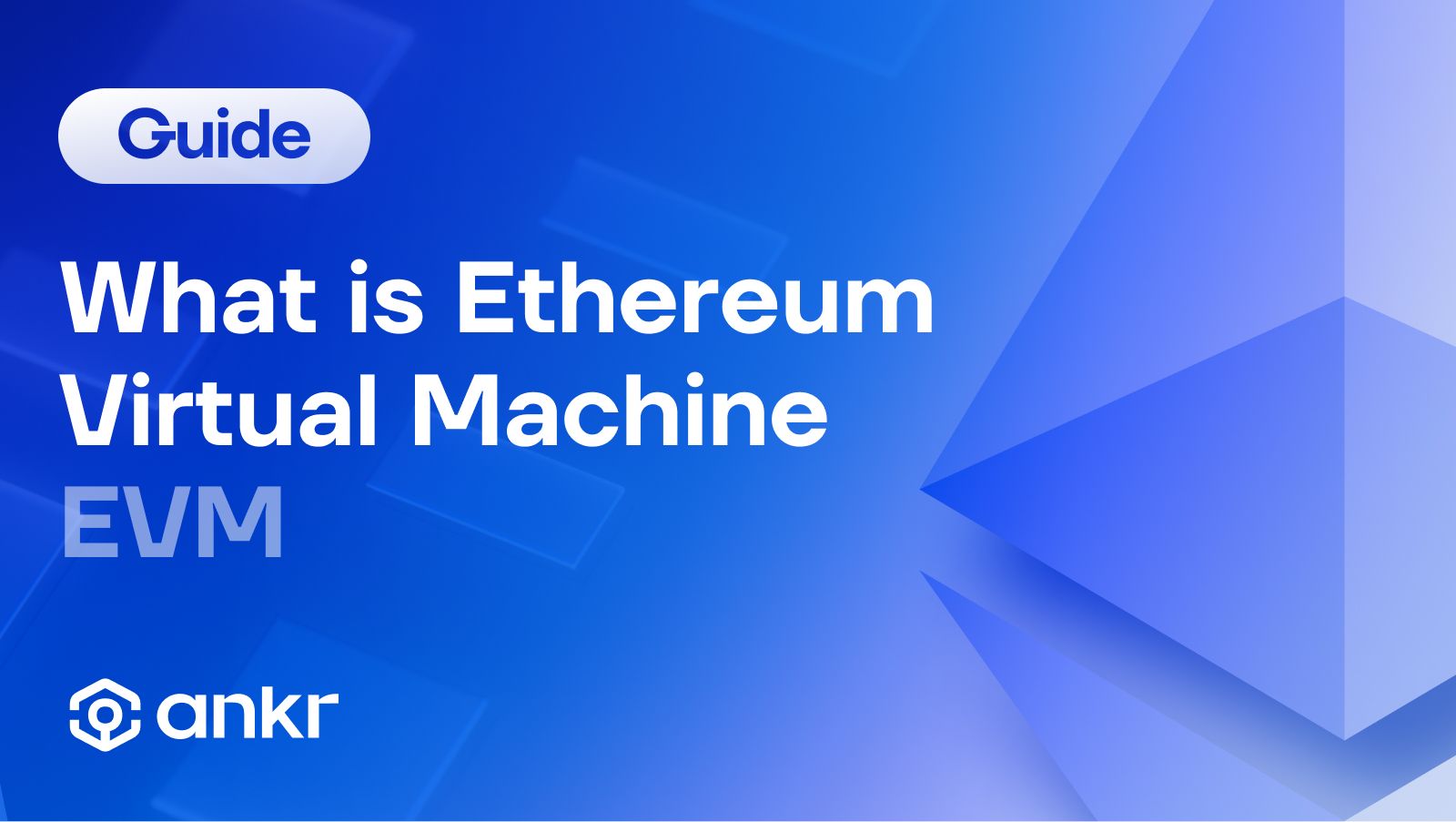What is the Ethereum Virtual Machine (EVM): The Complete Guide [2024]

Kevin Dwyer
February 8, 2024
8 min read

In the evolving landscape of blockchain technology, the Ethereum Virtual Machine (EVM) stands as a cornerstone of the Ethereum ecosystem. This comprehensive guide delves into the intricacies of the EVM, providing insights into its significance, architecture, operational mechanics, and its pivotal role in the future of decentralized applications.
Brief Explanation of What is EVM: Ethereum Virtual Machine
The Ethereum Virtual Machine (EVM) is the runtime environment for smart contracts on the Ethereum blockchain. It's a decentralized virtual machine that executes the code of smart contracts in a trustless manner, enabling developers to create applications that operate exactly as programmed without any possibility of downtime, censorship, fraud, or third-party interference.
Imagine the Ethereum Virtual Machine (EVM) as a giant, decentralized computer running inside the Ethereum blockchain. Instead of being controlled by one company or person, it's spread out across thousands of computers around the world.
This virtual computer's main job is to run smart contracts, which are like tiny, automatic programs that live on the blockchain. Think of them as vending machines with rules built in. Just like a vending machine only gives you a soda if you put in the right amount of money and make the right selection, a smart contract only does what it's programmed to do, based on specific conditions being met.
The cool thing is that this giant computer runs these contracts in a trustless and secure way. It's like everyone has a copy of the vending machine's code and can see exactly how it works, making it almost impossible to cheat or mess with it. This means developers can build applications that run exactly as planned, without worrying about downtime, censorship, fraud, or anyone interfering.
Importance of EVM in the Ethereum Ecosystem
EVM is fundamental to Ethereum's operation, serving as the layer that allows for the execution of smart contracts and the creation of decentralized applications (DApps). It provides a layer of abstraction between the executing code and the executing machine, ensuring that developers can write applications that run on a blockchain, irrespective of the underlying hardware.
Overview of its Role in Executing Smart Contracts
Smart contracts are self-executing contracts with the terms of the agreement directly written into code. The EVM interprets and executes these contracts by transforming high-level languages like Solidity into a form it can understand - bytecode. This process ensures that smart contracts behave in a predictable and secure manner.
Understanding the Architecture of EVM
The architecture of the EVM is designed to isolate the executing environment from the network, making it a sandboxed execution context. This design ensures that code runs independently, securing the network from potential vulnerabilities in smart contracts.
How EVM Executes Smart Contracts
The Ethereum Virtual Machine (EVM) executes smart contracts by interpreting bytecode, compiled from high-level languages like Solidity, through fundamental operations called opcodes. When a smart contract is deployed, nodes across the decentralized Ethereum network independently process the bytecode, ensuring consistency. The execution involves initialization, setting state variables, and responding to user-triggered transactions. Gas, a unit representing computational work, is consumed during these operations, with users incentivizing miners. This decentralized process emphasizes the transparency and security of smart contract execution on the Ethereum platform.
Step-by-step Process of Executing Smart Contracts on EVM
Compilation:
- Developers write smart contracts in high-level languages (e.g., Solidity).
- Code is compiled into bytecode, a machine-readable format.
Deployment:
- Bytecode is included in a transaction.
- The transaction is broadcasted, specifying the smart contract's deployment address.
Initialization:
- EVM initializes the contract upon deployment.
- The constructor function executes, setting initial state variables.
Execution:
- Users trigger transactions by interacting with the contract.
- EVM processes bytecode, interpreting opcodes for function execution.
State Changes:
- Execution may lead to changes in the Ethereum blockchain's state.
- Includes updates to variables, asset transfers, or interactions with other contracts.
Gas Consumption:
- Each operation consumes gas, a unit for computational work.
- Users pay for gas to ensure network functionality and incentivize miners.
Consistency Across the Network:
- All participating nodes independently execute the contract's bytecode.
- Consensus mechanism ensures uniformity across the decentralized network.
Explanation of the Bytecode and Opcodes
EVM bytecode is a series of bytes that represent operations for the EVM to execute. These operations, or opcodes, are the fundamental instructions that guide the EVM's execution logic, ranging from arithmetic operations to memory access.
Ethereum Gas and EVM Optimization
Ethereum Gas is the unit measuring computational work in transactions, with users paying to incentivize miners and maintain network functionality. EVM optimization is a key strategy to minimize gas consumption and enhance the efficiency of smart contract execution. Techniques include code optimization, meticulous storage management, and thoughtful consideration of data types. Developers prioritize EVM optimization to reduce transaction costs and improve the overall performance of decentralized applications on the Ethereum platform.
Tips for Optimizing Smart Contracts for Efficient EVM Execution
- Minimize Storage Operations:
- Reduce the frequency of storage operations, considering their higher gas costs.
- Utilize Efficient Data Types and Structures:
- Choose data types and structures that optimize resource utilization and minimize gas consumption.
- Optimize Contract Logic:
- Streamline and simplify the logic of smart contracts to reduce overall complexity, contributing to more efficient execution on the Ethereum Virtual Machine (EVM).
EVM and Ethereum Development
The Significance of EVM for Developers in the Ethereum Ecosystem
For developers, the EVM provides a robust and secure environment for deploying and executing smart contracts, enabling the creation of a wide range of decentralized applications.
Tools and Frameworks for EVM-based Development
- Truffle Suite: A development environment, testing framework, and asset pipeline for blockchains using the EVM.
- Remix IDE: An open-source web and desktop application for developing Ethereum smart contracts.
- Hardhat: A development environment to compile, deploy, test, and debug Ethereum software.
- OpenZeppelin: A library for secure smart contract development.
- Ganache: A personal blockchain for Ethereum development you can use to deploy contracts, develop applications, and run tests.
Role of EVM in Ethereum 2.0
In Ethereum 2.0, the Ethereum Virtual Machine (EVM) holds a crucial role during the network's transition from proof-of-work to proof-of-stake consensus. Its significance lies in ensuring compatibility with existing smart contracts while accommodating the new PoS mechanism introduced for scalability and sustainability. The EVM remains central in maintaining the integrity of decentralized applications and providing a standardized environment for developers, thereby facilitating seamless smart contract execution across the evolving Ethereum network.
Explanation of Ethereum 2.0's Transition to a Proof-of-Stake (PoS) Consensus
Ethereum 2.0 represents a significant upgrade, transitioning from proof-of-work (PoW) to proof-of-stake (PoS) consensus. This change aims to improve scalability, security, and sustainability. The EVM continues to play a crucial role in this transition, ensuring compatibility and seamless execution of smart contracts.
EVM-Compatible Blockchains
Binance Smart Chain (BSC):
BSC is a blockchain network developed by Binance, designed to run parallel to Binance Chain. It incorporates the EVM, allowing seamless compatibility with Ethereum-based assets and smart contracts.
BSC Pros:
- High throughput and lower transaction fees compared to Ethereum.
- Direct integration with the Binance ecosystem, fostering interoperability.
BSC Cons:
- Centralized nature, as it relies on a smaller number of validators compared to Ethereum.
- Concerns regarding decentralization and censorship resistance.
Polygon (Matic):
Formerly known as Matic, Polygon is a layer 2 scaling solution for Ethereum. It leverages the EVM, enabling developers to deploy and run Ethereum-compatible smart contracts on its network.
Matic Pros:
- Provides scalability solutions with sidechains and plasma frameworks.
- Offers a range of interoperable solutions for decentralized applications.
Matic Cons:
- Dependency on a set of validators for security, raising centralization concerns.
- Potential challenges in achieving complete decentralization.
Avalanche (Avax):
Avalanche is a platform for launching decentralized applications and custom blockchain networks. It is EVM-compatible, allowing developers to deploy Ethereum-based applications on the Avalanche network.
Avax Pros:
- High throughput, quick finality, and low transaction costs.
- Supports the creation of custom blockchains tailored to specific needs.
Avax Cons:
- Lower adoption and network effects compared to more established platforms like Ethereum.
- Security concerns related to a smaller user base and network validators.
These blockchains have adopted the EVM, enabling interoperability and the transfer of assets and data across different networks, highlighting the benefits and challenges of EVM interoperability.
Smart Contracts: The Building Blocks of Decentralized Execution
Before delving into the intricacies of EVM, understanding smart contracts is paramount. Smart contracts are self-executing contracts with the terms directly written into code. They automate and enforce agreements on the blockchain, eliminating the need for intermediaries and enhancing transparency in transactions.
Future Trends and Developments in EVM
As the demand for decentralized applications grows, the EVM is continuously evolving to meet the needs of the community. Innovations in scalability, security, and efficiency are underway, ensuring that the EVM remains at the forefront of blockchain technology.
In conclusion, the Ethereum Virtual Machine (EVM) is a pivotal component of the Ethereum ecosystem, enabling the execution of smart contracts and the development of decentralized applications. Its importance cannot be overstated, as it continues to adapt and evolve, paving the way for a more secure, efficient, and interoperable blockchain future.
Join the Conversation on Ankr’s Channels
Twitter | Telegram Announcements | Telegram English Chat | Help Desk | Discord | YouTube | LinkedIn | Instagram | Ankr Staking



